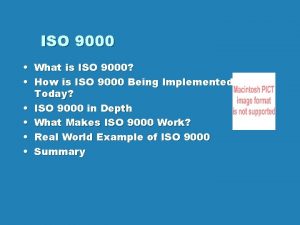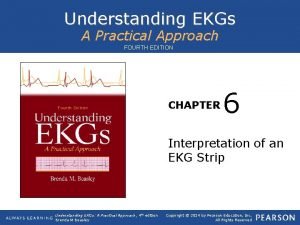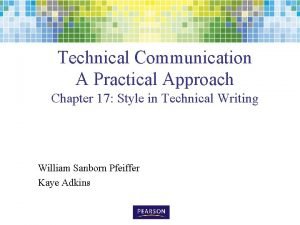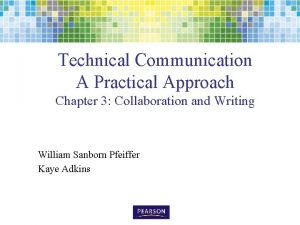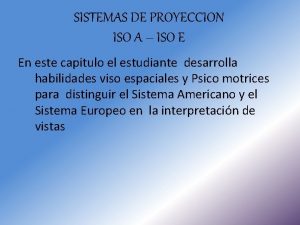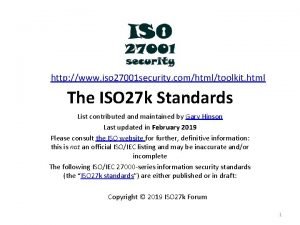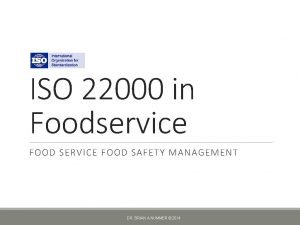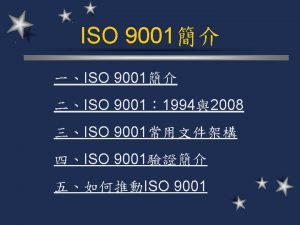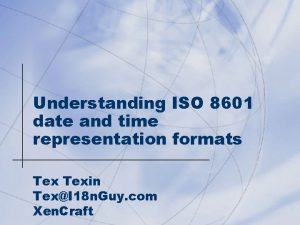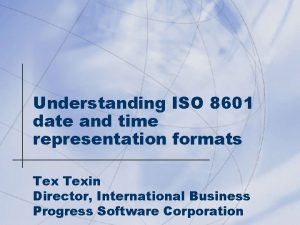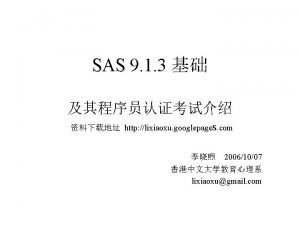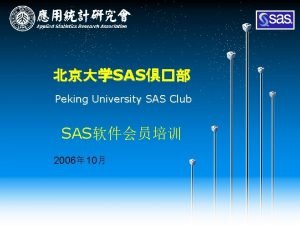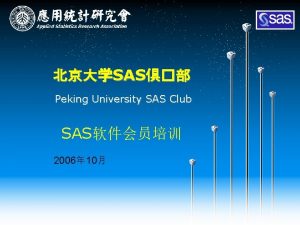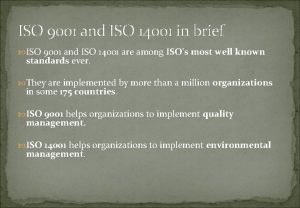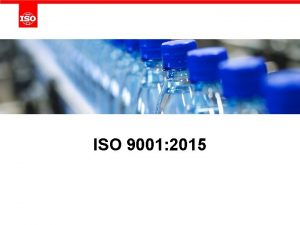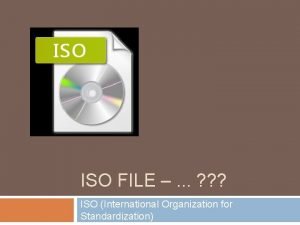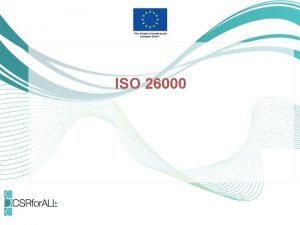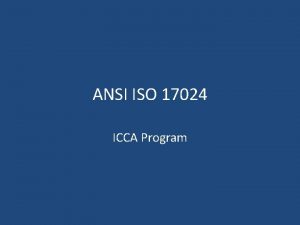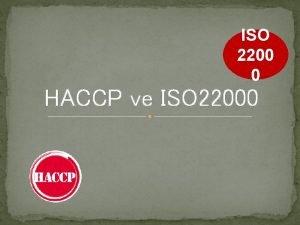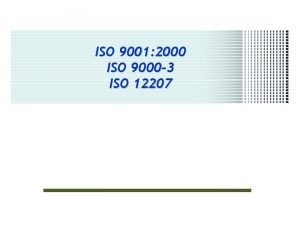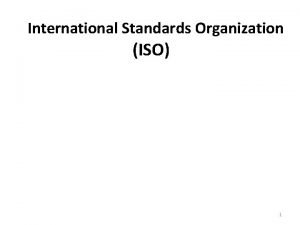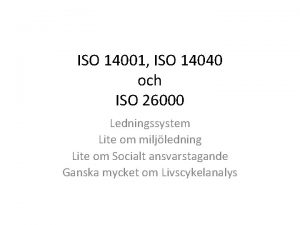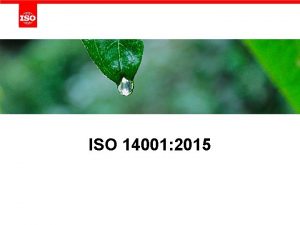ISO 8601 and SAS A Practical Approach Derek





















- Slides: 21

ISO 8601 and SAS : A Practical Approach ® Derek Morgan PAREXEL International

Section 1: What Is ISO 8601?

The ISO 8601 Standard • Internationally accepted methodology describing dates and times using numbers • Standard covers: – Dates – Time of day – Date and time – Coordinated Universal Time (UTC) – Local time with offset to UTC – Time intervals and recurring time intervals

The ISO 8601 Standard • Removes problems of: – Translation • August can be expressed as “août”; “август”; “agosto”; “八月” – Local norms for expressing dates • 03 -08 -2016 • Is it March 8, 2016 or August 3, 2016?

Basic vs. Extended Notation • Basic is just the numbers • Extended uses delimiters Basic Notation 20160614 T 1422 20160614 T 14223774 Extended Notation 2016 -06 -14 T 14: 22 2016 -06 -14 T 14: 22: 37. 74

Section 2: SAS and ISO 8601 ®

A Few Basics • SAS maintains dates and times as numbers relative to a reference point – Needs an exact number • ISO 8601 allows for missing components – In standard SAS dates and times, missing components=missing value • SAS can handle ISO dates with missing components – Separate from normal SAS dates and times if you need it

Reading Extended Notation ISO 8601 Dates and Times into SAS ® • Use informats - No different than any other complete SAS date, time or datetime • Create a SAS datetime from an ISO 8601 datetime: – xxxdtm = INPUT(xx. DTC, E 8601 DT. ); • Create a SAS date from an ISO 8601 date (or datetime): – xxxdt = INPUT(xx. DTC, E 8601 DA. ); • BUT pick the time from the complete SAS datetime created above – xxxtm = TIMEPART(xxxdtm);

Reading Basic Notation ISO 8601 Dates and Times into SAS ® • The informats for basic notation begin with the letter “B” – Create a SAS datetime with B 8601 DT. – Create a SAS date with B 8601 DA. – STILL pick the time from the complete SAS datetime you created using TIMEPART() WARNING!!! Basic notation informats will substitute 0 for missing time components, and 1 for missing day or month components!

Basic vs. Extended Notation Informats ISO 8601 Character String 2014 -03 -26 T 16: 14 2014 -06 -24 2414 -09 Read with E 8601 DT. Read with B 8601 DT. 26 MAR 2014: 16: 14: 00 24 JUN 2014: 00: 00 01 SEP 2014: 00: 00 You may wind up with an unexpected imputation using the basic notation informat!

Writing ISO 8601 Dates and Times in SAS the Normal Way ® • Use formats - No different than any other complete SAS date, time or datetime. • IF dt_value is a valid SAS datetime value: – vsdtc = PUT(dt_value, E 8601 DT. ) creates an ISO 8601 datetime – vsdt = PUT(dt_value, E 8601 DN. ) creates an ISO 8601 date from a datetime – vstm = PUT(TIMEPART(dt_value), E 8601 TM. )

Writing ISO 8601 Dates and Times in SAS the Normal Way ® • IF dt_value is a valid SAS date: – vsdt = PUT(dt_value, E 8601 DA. ) creates an ISO 8601 date

SAS ISO 8601 Facility ® • Stored internally in CHARACTER variables – Needs CHARACTER formats and informats to make any sense, just like normal dates and times – Can accommodate missing components – Can perform simple, automatic imputation in calculations • This may not be what you want • Recommend doing any imputation before using this for calculations

How SAS Stores ISO 8601 Values ® SAS Formatted Datetime SAS Datetime Value 2015 -04 -20 T 15: 05: 30 1745161530 20 APR 2015: 05: 30 2016 -12 -22 T 06: 40 1798008000 22 DEC 2016: 06: 40: 00 2014 -01 -15 2015 -09 2017 -02 -15 T 02 2016 Original ISO 8601 String SAS ISO 8601 Internal Value 2015420150530 FFD 2016 C 220640 FFFFD 2014115 FFFFD 20159 FFFFFD 201721502 FFFFFFD 2016 FFFFFFD

ISO 8601 Durations and Intervals • Duration describes a period of time: PT 17 H 41 M P 2 DT 10 H 30 M • • Intervals describe start and end of a period 3 Forms: Datetime/Datetime: 2016 -08 -05 T 17: 19/2016 -08 -06 T 11: 00 Datetime/Duration: 2016 -08 -05 T 17: 19/P 0 Y 0 M 0 DT 17 H 41 M 0 S Duration/Datetime: P 0 Y 0 M 0 DT 17 H 41 M 0 S/2016 -08 -06 T 11: 00

How Do You Calculate ISO Durations and Intervals? 1. Divide end date-start date by several factors to get years, months, days, hours, etc. - or 1. Use the SAS interval function INTCK() to get years, months, days, hours, etc. 2. Concatenate the results with the appropriate delimiters

There’s An Easier Way DATA duration 1; SET full_datetimes; LENGTH aedur $ 32; CALL IS 8601_CONVERT('dt/dt', 'du', aestdtm, aeendtm, aedur); FORMAT aedur $N 8601 E. ; RUN; Event Start Date/Time Event End Date/Time Duration 22 DEC 2016: 00: 00 23 DEC 2016: 00: 00 P 1 D 15 JAN 2014: 00: 00 04 JUN 2014: 00: 00 P 4 M 20 D 25 FEB 2013: 00: 00 16 MAY 2017: 00: 00 P 4 Y 2 M 19 D

The IS 8601_CONVERT Routine • Syntax: CALL IS 8601_CONVERT(convert-from, convertto, <from-variables>, <to-variables>, <date-timereplacements>); • Works with SAS ISO datetimes and SAS datetimes, interchangeably.

And That’s the Practical of it. . . • The ISO 8601 standard is an internationally accepted methodology describing dates and times using numbers • There are informats to read ISO 8601 dates and times • There are formats to write ISO 8601 dates and times • SAS can handle missing components in ISO 8601 dates and times - separate facility from normal dates and times • The IS 8601_CONVERT routine calculates ISO durations easily

Any Questions? • References: • Harnessing the Power of SAS® ISO 8601 Informats, Formats, and the CALL IS 8601_CONVERT Routine; Kim Wilson, SAS Institute Inc. , Cary, NC, USA, Pharma. SUG 2012 • The Essential Guide to SAS® Dates and Times, Second Edition. Cary, NC: SAS Institute Inc. ; Morgan, Derek P. 2014.

Thank You! Derek Morgan, PAREXEL International mrdatesandtimes@gmail. com
 As iso 8601-2007
As iso 8601-2007 Norma iso 9000
Norma iso 9000 Understanding ekgs a practical approach
Understanding ekgs a practical approach Style in technical communication
Style in technical communication Practical approach pediatrics
Practical approach pediatrics Technical communication a practical approach
Technical communication a practical approach Difference between virtual and datagram circuit
Difference between virtual and datagram circuit Deep learning approach and surface learning approach
Deep learning approach and surface learning approach Iso-e
Iso-e Iso 8583 to iso 20022 mapping
Iso 8583 to iso 20022 mapping Iso 27550
Iso 27550 Iso 9001 iso 14001 ohsas 18001 comparison
Iso 9001 iso 14001 ohsas 18001 comparison Iso 9000 iso 22000
Iso 9000 iso 22000 Everyone should bring ___ mother to the picnic
Everyone should bring ___ mother to the picnic Cognitive approach vs behavioral approach
Cognitive approach vs behavioral approach Waterfall strategy in international marketing
Waterfall strategy in international marketing Multiple approach-avoidance
Multiple approach-avoidance Cognitive approach vs behavioral approach
Cognitive approach vs behavioral approach What is research approach definition
What is research approach definition Diagram for traditional approach
Diagram for traditional approach Derek comartin
Derek comartin 3825 greenspring avenue
3825 greenspring avenue

